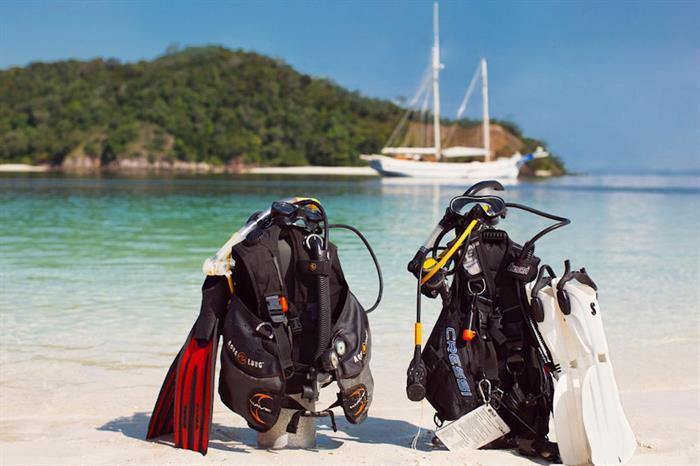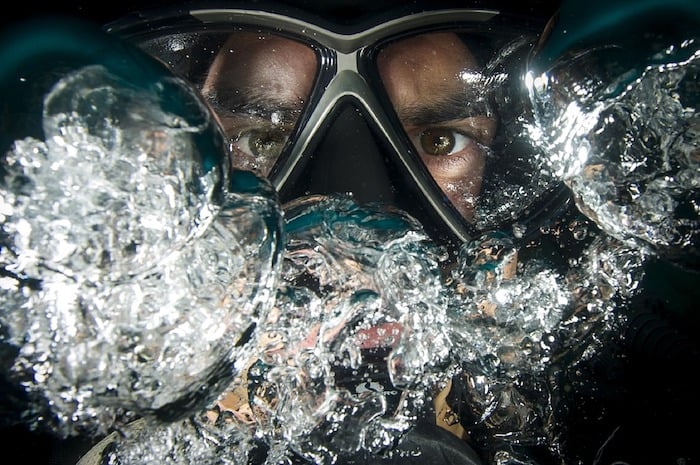Top Tips for Buying Your Own Dive Gear

One of the joys of learning to dive is buying your own dive gear but the choices can be overwhelming as a new diver. As dive gear technologies continue to evolve, there is always new top dive gear to choose from. It can be difficult to know when and where to start, plus which pieces of dive gear to prioritise and invest in.
When Should I Buy My Own Dive Gear?
Making the decision to buy your dive gear is very personal and different people will choose to buy at different times. Some people like to buy their first pieces of gear when they qualify as divers and it is a great way of celebrating that achievement. Other people will wait whilst they gain more scuba diving experience and perhaps save up for the dive gear they would really like to own.
One of the advantages of waiting before buying new dive gear is experiencing different pieces of rental gear and diving conditions in the meantime. Both of which allow divers to better understand what gear works for them. A diver who focuses on cold water diving in strong currents may need considerably different dive gear for warm water diving, such as that found during Seychelles liveaboard diving.
Why Should I Buy My Own Dive Gear?
Owning and maintaining your own dive gear gives you the confidence and assurance that your gear is in top condition and unlikely to fail during a dive. It allows you to know the history of your dive equipment, which further reduces the chance of gear failure. You can also ensure dive comfort by owning the right gear that fits you perfectly. Owning your own dive gear is a great investment.
How much should I spend on dive gear?
It is wise to remember that price tag isn’t the most important consideration when choosing dive gear. The most expensive item will not necessarily be the right choice for you. There are great dive kit options available for all budgets and it is important to first focus on functionality and fit rather than cost. Equally though, divers should avoid purchasing cheap items such as supermarket masks, which are not designed and tested for scuba diving purposes.
What do you need to go scuba diving?
The main pieces of gear you will need to go scuba diving are:
- Mask
- Buoyancy control device
- Octopus (regulators, gauges and connecting hoses)
- Scuba air tank
- Dive computer
- Weighs & belt
- Exposure suit
- Fins
It is not necessary to own all of that equipment though, especially expensive and higher maintenance items that are not easy to travel with; weights and air tanks being good examples of that. Some divers will choose to own just a few pieces of dive gear whereas others will want to carry additional items such as booties, a snorkel, and a hood.
The potential list of scuba gear is almost endless, so here are our top dive gear items to invest in:

Mask
A dive mask allows you to see underwater and is one of the best items to own from the beginning of your time as a diver. It is important to have a correctly fitting mask that doesn’t flood with water and provides an excellent field of vision during your dives. We recommend choosing a mask that also allows you to equalise the mask air space easily, pinch your nose easily to equalise your ears, and one that is comfortable. More information about choosing the right mask can be found in Top Tips for Choosing the Right Mask.
Dive Computer
A dive computer is often the first piece of dive gear a new diver will buy. It is an important piece of equipment that constantly monitors the diver’s depth and bottom time, whilst continually calculating the no-decompression status. They also monitor ascent rates, log each dive, and can do much more.
When selecting a dive computer, it is important to consider how easy it is to use during a dive, the type of display you prefer for clear viewing, and where you will be mounting it on your dive kit. It is also worth thinking about your dive experience level and any additional features you would like the computer to include. More information about choosing the best dive computer for your needs can be found in The Best Dive Computers.
A popular choice for an entry-level computer is the Suunto Zoop. This computer is easy to use and great value.
Exposure suit
There is nothing quite like an ill-fitting, old exposure suit to end a dive early due to being cold. Owning your own exposure suit needn’t be expensive and will help ensure warmth and comfort during your dives.
The first considerations are the type of diving you will be doing and how easily you feel the cold, as they will dictate the thickness and type of suit to buy.
Cold water divers, or those doing multiple dives each day, often choose a dry suit with thermal undersuit for added warmth, even at warm water destinations such as Egypt. Dry suits keep the diver entirely dry, but they can be expensive. An alternative is to choose a 7mm wetsuit for cooler water diving, and a 3 to 5mm wetsuit for warm water diving.
A semi-dry suit is another good alternative. It is essentially a wetsuit with arm, leg and neck seals, that minimise the flow of water within the suit. This prevents cooler outside water from flowing in and cooling the body repeatedly during dives. They are a great option for added warmth without the expense of a dry suit and can be combined with a wetsuit jacket for even more warmth. The Aqua Lung Balance Comfort is a good example of this style of suit.
Buoyancy Control Device (BCD)
The BCD is an essential piece of dive gear. It holds the other dive gear in place, ensures divers float on the surface, and allows correct buoyancy during dives. The right BCD is well worth investing in.
The fit of a BCD is important and different styles and sizes are available. It is important to try BCDs on before buying one, preferably whilst wearing your exposure suit, to find the right fit. Be sure to test all of the valves for accessibility and check the straps and pockets are also easy to reach. People who suffer with back pain should consider which type of back plate is the most comfortable and see if the pockets allow dive weights to be set up to minimise any loading on the spine.
Fins
Fins come in a variety of designs, shapes and sizes and the type of fin you will need depends on the type of diving you intend to do. It is important to choose a pair that fits properly, to prevent sore feet and leg muscle fatigue when diving.
Full-foot fins don’t require dive booties and are good for warm water diving. However, they can become uncomfortable if grains of sand find their way into the fin and rub against the skin during a dive.
Open-heel fins require booties and are good for cool water diving and for their ease of removal. They are also good for shore diving as wearing booties can provide more grip when walking over uneven surfaces to the dive entry point. Spring heel straps are ideal with open-heel fins for ease of fin removal.
Please see our other tips for;










